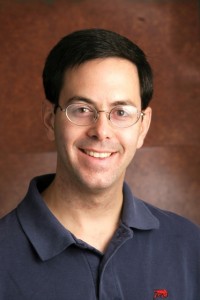
ASU bioengineer makes key contribution to cancer treatment research

ASU bioengineer Michael Caplan provided biophysical expertise for a research project seeking ways to target cancerous tumors with therapeutic biomaterials without damaging healthy body tissues.
Posted December 14, 2012
Michael Caplan shares authorship of a paper on cancer treatment research published this week this week in the prestigious Proceedings of the National Academy of Sciences journal.
Caplan is an associate professor in the School of Biological and Health Systems Engineering, one of Arizona State University’s Ira A. Fulton Schools of Engineering.
The paper focuses on results of research led by Robert Gillies at the H. Lee Moffitt Cancer Center and Research Institute. Caplan has been collaborating on the project since 2005.
The research team explored potential methods of making therapeutic biomaterials stick only to cancerous tumors in the body – without threatening to damage healthy body tissue – by combining two short amino acid chains, each of which stick to different molecules on the surface of cancer cells.
Researchers looked at whether these therapeutics could accumulate preferentially in the tumor if the targets for the two components were present, and compared that to the accumulation when only one of the targets was present.
=The paper detailing their findings is titled “Heterobivalent ligands target cell-surface receptor combinations in vivo.”
Caplan explains: “We take two peptides – think short proteins – and link them together with a short linker, a polyethylene glycol linker. The paper is about a targeting molecule that has only two peptides that are different, called heterobivalent ligands.”
The receptors in the paper’s title refer to “transmembrane proteins on cells – proteins that go all the way through the cell membrane,” Caplan says. “Certain receptor types are expressed more on cancer cells than on normal cells. Those receptors are the targets. In this case we have targeted CCK2R (CCK receptor) and MC1R (melacortanin receptor). There is a peptide that will bind to each receptor, and these are linked together to make the heterobivalent ligand.”
In this way the researchers showed that combining these two components allows the therapeutics to accumulate specifically in the targeted tumor but not in other body tissues.
The results point to ways to provide effective cancer treatment using lower doses of medicines, which would cause fewer or less intense negative side effects, Caplan says.
Caplan worked on biophysical aspects of the research, producing mathematical modeling showing precisely how the molecules behave. That helped fellow researchers understand why certain molecules worked better than others for the therapeutics delivery and treatment processes.
In addition to Gillies and Caplan, authors of the paper are Liping Xu and David L. Morse of the Moffitt Center, and Jatinder S. Josan, Victor J. Hruby, Eugene A. Mash, Josef Vagner and Ronald Lynch of the University of Arizona.
Media Contact:
Joe Kullman, [email protected]
(480) 965-8122
Ira A. Fulton Schools of Engineering



































